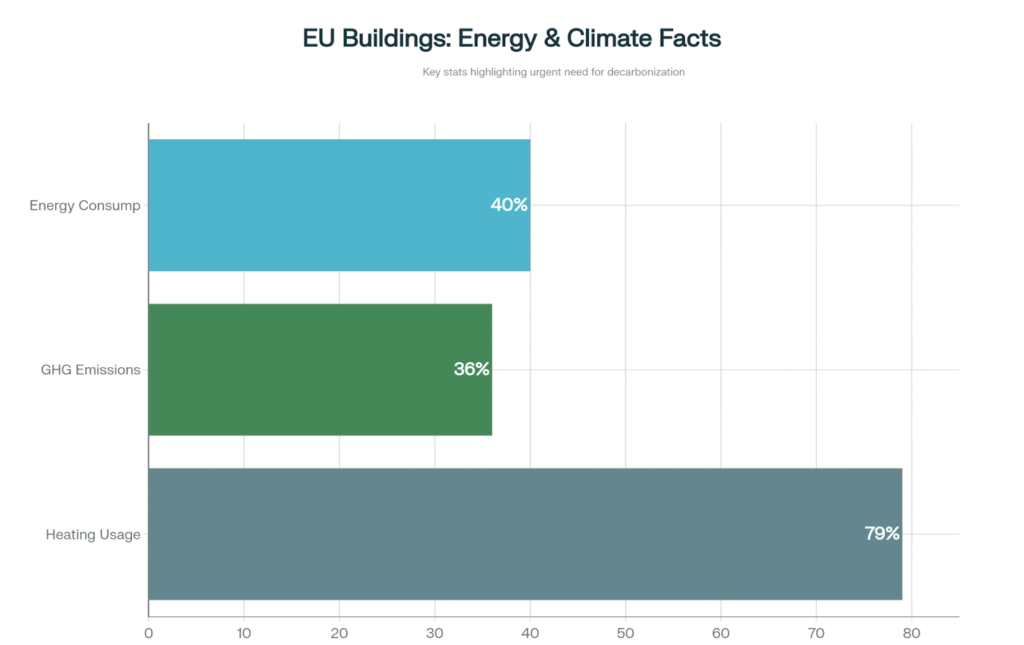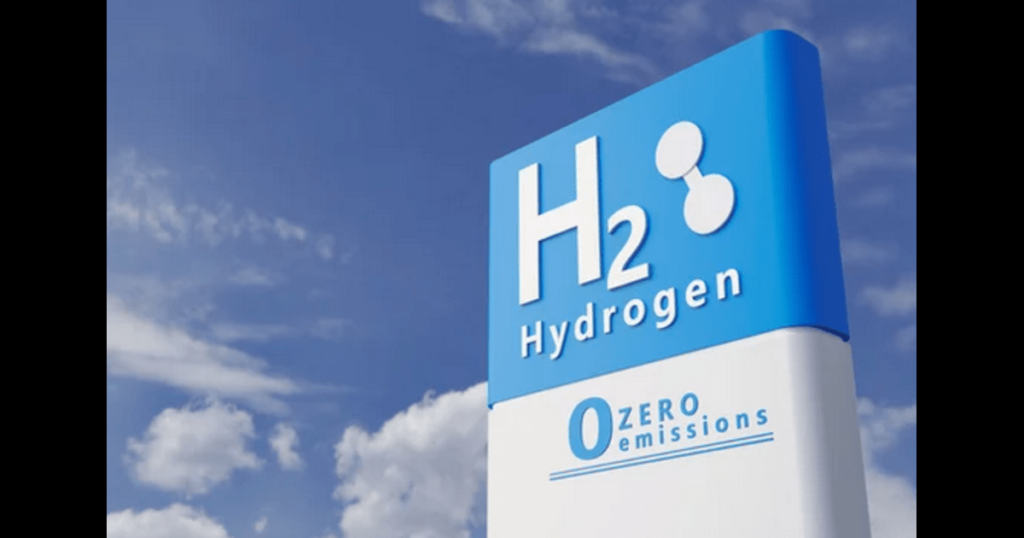Energy consumption & emissions are a rising issue for the EU. The European Union faces a critical challenge in achieving climate neutrality by 2050. Why? Because buildings consume 40% of the EU’s total energy and generate 36% of greenhouse gas emissions. This makes them the single largest energy consumer and a major contributor to climate change. Understanding these statistics is essential for supporting the renewable energy transition that projects like H2Heat are pioneering across Europe.

Scale of the Challenge of Energy Consumption
The magnitude of building-related energy consumption and emissions across the European Union reveals why urgent action is necessary. Buildings account for 40% of total energy consumption and 36% of greenhouse gas emissions in the EU, with an overwhelming 79% of that energy dedicated to heating water and air conditioning systems. This massive energy demand stems largely from an aging building stock, where 85% of buildings were constructed before 2000 and 75% demonstrate poor energy performance.
The European Environment Agency reports that buildings represented 34% of energy-related emissions in 2022, highlighting the sector’s continued reliance on fossil fuels. Despite a 34% reduction in greenhouse gas emissions from buildings between 2005 and 2022, the pace of decarbonization remains insufficient to meet the EU’s ambitious climate targets.
The heating and cooling demand creates particular challenges for decarbonization efforts. Current heating systems predominantly rely on fossil fuels, with gas boilers being the most widely used heating technology across Europe. This dependency on conventional heating methods explains why the building sector continues to lag behind other sectors in emissions reduction, despite technological advances and policy interventions.
Current Progress and Future Requirements
The European Union has established clear decarbonization pathways for the building sector, requiring a 60% reduction in greenhouse gas emissions by 2030 and complete decarbonization by 2050. However, current progress falls significantly short of these targets.
The EU Buildings Climate Tracker reveals that the sector is over 40% behind the necessary decarbonization pathway. Key indicators include CO2 emissions reduction, final energy consumption, renewable energy share, and renovation investments all lagging substantially.
Annual renovation rates remain critically low at just 1% per year, far below the 2% renovation rate needed to achieve climate goals. The renewable energy share in buildings has increased by only 6.3 percentage points since 2015, reaching 28.9% in 2022 when the target value was 41%. This slow growth primarily results from inadequate expansion of renewable energy for heating and cooling applications.
Member States’ national projections indicate that existing policies and measures will reduce greenhouse gas emissions from buildings to 42% below 1990 levels by 2030, falling short of what is required for climate neutrality. With additional measures, emissions could reach 48% below 1990 levels, still insufficient for the transformation needed.
Green Hydrogen as a Decarbonization Solution
Green hydrogen emerges as a promising solution to address the building sector’s decarbonization challenges. Particularly for heating applications where direct electrification faces limitations. Hydrogen can provide carbon-free energy storage capacity that can be used when renewable electricity is lacking, offering crucial flexibility for energy systems with high renewable penetration.
The advantages of hydrogen for building heating include its ability to utilize existing gas infrastructure with modifications, provide seasonal energy storage, and deliver high-temperature heat for industrial and commercial applications.
Hydrogen enables the transportation of renewable energy from generation to consumption centers, addressing geographical imbalances in renewable resource availability across Europe.
Projects like H2Heat demonstrate the practical application of green hydrogen in building decarbonization. The initiative produces hydrogen using renewable energy and employs innovative 100% hydrogen-powered cogeneration (H2-CHP) systems combined with heat pumps to provide heating for hospital facilities. This integrated approach achieves over 50% reduction in CO2 emissions compared to conventional heating systems.
The H2Heat Innovation Model
The H2Heat project showcases how green hydrogen can transform building energy systems through technological innovation and integrated solutions. Located in the Canary Islands, the project utilizes Stargate’s 0.5MW electrolyser with advanced ceramic-based electrode materials to produce green hydrogen from renewable energy sources. This hydrogen powers a sophisticated heating system that combines 2G’s hydrogen-powered cogeneration technology with heat pump integration.
The project’s innovative approach addresses multiple aspects of building decarbonization simultaneously. The H2-CHP system achieves 80% efficiency in converting hydrogen to heat and energy, while the integrated heat pump provides additional thermal output with a minimum coefficient of performance of 4. This combination enables the system to meet 90% of the hospital’s total heating requirements while dramatically reducing carbon emissions.
The project includes comprehensive digital control systems for energy management, demand management, and SCADA monitoring, ensuring optimal performance across variable renewable energy supply conditions.
The Why – Economic and Environmental Benefits
The transition to green hydrogen heating systems offers substantial economic and environmental advantages that support broader renewable energy adoption. Green hydrogen production costs are expected to fall to €2-3 per kilogram within 10 years, driven by reducing electrolyser capital expenditure by 70-80% and falling renewable energy costs. This cost reduction pathway makes hydrogen increasingly competitive with conventional heating fuels.
Environmental benefits extend beyond direct emission reductions to include improved air quality, reduced dependence on fossil fuel imports, and enhanced energy security. The H2Heat project targets 500 tons per year reduction in heating carbon emissions initially, scaling to 3,000 tons per year by 2030 as the technology expands across the Canary Islands Health Service hospital network.
The integration of renewable energy sources for hydrogen production creates additional environmental benefits by enabling higher utilization rates of variable renewable generation.
Supporting the Renewable Transition
The evidence from EU building sector statistics and innovative projects like H2Heat demonstrates the critical importance of diversified decarbonization strategies that include green hydrogen alongside electrification and energy efficiency improvements. Buildings hold the key to mitigating peak energy demand, and renewable hydrogen provides essential flexibility for managing seasonal heating requirements and variable renewable energy supply.
The Zero Net Emissions 2030 Health Strategy adopted by the Canary Islands Health Service exemplifies the institutional commitment necessary for large-scale renewable transitions. This strategy positions green hydrogen as a central element in achieving comprehensive decarbonization across essential public services, creating replicable models for implementation throughout Europe.
Supporting renewable transitions requires recognizing that the building sector is emissions-intensive and hard-to-abate, necessitating innovative solutions that can work within existing infrastructure constraints while delivering substantial emission reductions. Green hydrogen offers a pathway that complements electric heat pumps and other renewable technologies, providing the flexibility needed for complete building sector decarbonization.
Call to Action: Join the Renewable Revolution
The transition to sustainable building heating represents one of the most significant opportunities for climate action available today. With buildings responsible for 40% of EU energy consumption and 36% of greenhouse gas emissions, supporting renewable solutions like green hydrogen can drive transformational change across European communities.
Citizens, businesses, and policymakers can support this transition by advocating for renewable heating policies, investing in clean energy technologies, and supporting innovative projects that demonstrate practical pathways to decarbonization.
The H2Heat project shows that green hydrogen solutions are not just theoretical possibilities but operational realities that can deliver substantial emission reductions while maintaining energy security and reliability.
The path to a carbon-neutral future runs directly through our buildings, and green hydrogen provides an essential tool for achieving this transformation while supporting economic growth, energy independence, and environmental sustainability across Europe.


